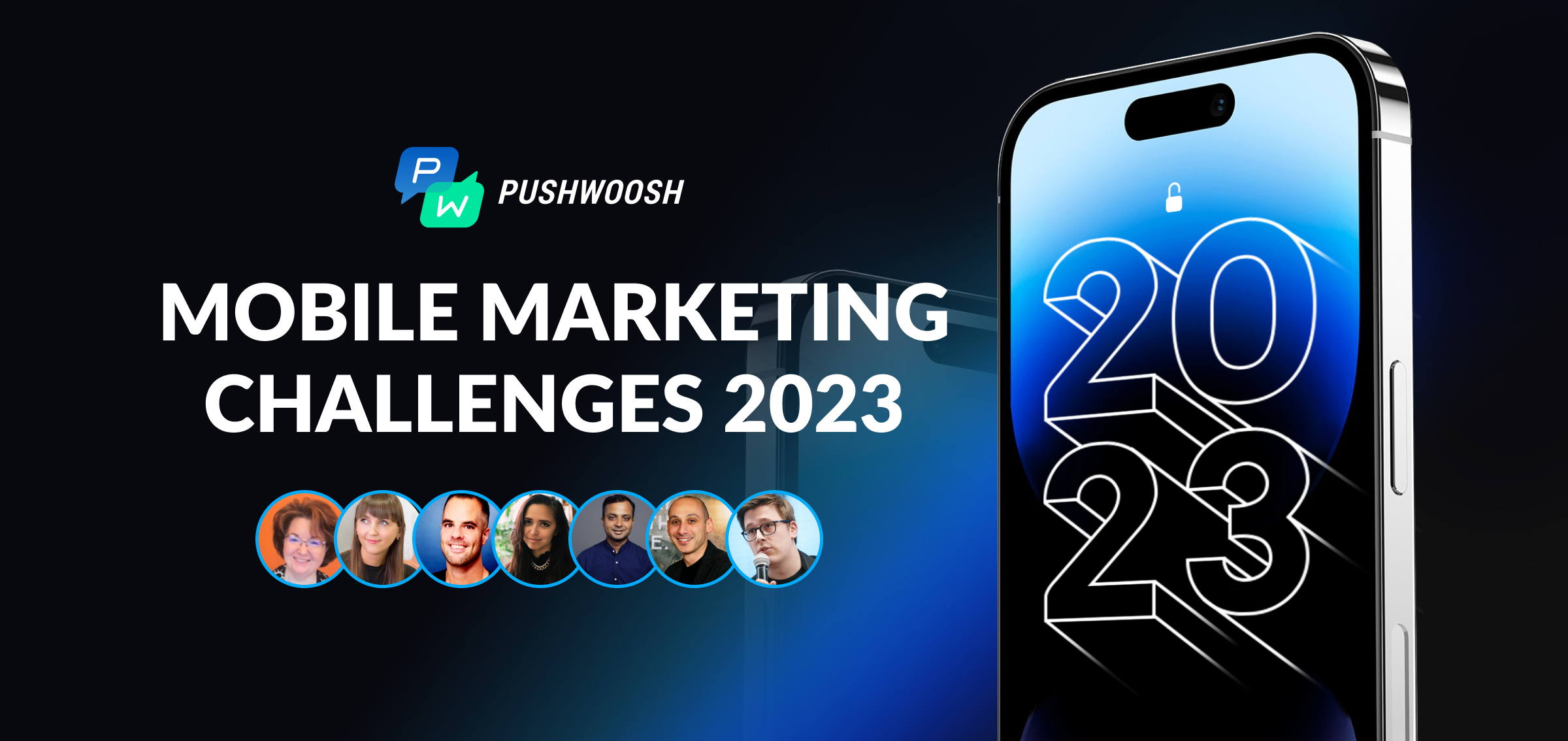When the clock strikes twelve, mobile marketers will have many wishes to make. Among others: to overcome data privacy issues, resolve the acquisition vs. retention dilemma and see positive growth trends in marketing and business reports. What kind of holiday magic can help to make these wishes come true?
We at Pushwoosh decided not to wait for the magic to happen — instead, we’ve talked to our favorite mobile marketing experts and written down their recommendations for a successful 2023. Here they are:
1. Get access to the data needed for personalization
Using customer data for personalization in marketing has become a norm rather than a trend — to the point where 71% of consumers expect to receive personalized interactions from companies and get frustrated when they don’t.
However, the challenge arises: with every OS version update, data privacy restrictions undermine another feature that would be so useful for targeting communications. For example, even the default permission to send push notifications on Android (which many app marketers took for granted) will be withdrawn in the new version of Google's OS…
Under these conditions, what will the treasured data hunt look like in 2023? Peggy Anne Saltz shares her vision:

Peggy Anne Saltz
Lead Analyst & Founder at Mobile Groove
In a post-privacy world, marketers must aim to personalize all aspects of their marketing and advertising and accept that they will have to shift from a pure performance marketing mindset to focusing on what real people do in real time. This means harnessing data around user behavior and the actions consumers embrace or avoid in and outside the app. And, since no segment is static and there isn’t just one customer journey, marketers must also combine real-time analytics, segmentation, and engagement functionality to adapt to minute changes in customer preferences at any given moment, as opposed to after the fact.
The end game is about visibility and drawing from demographic data and behavioral insights to see the “who” and “what” of your audience. But understanding the data around what customers do, where they are, and what device they use in real-time will be table stakes sooner than we think. In 2023, gaining and keeping a competitive edge will demand marketers go beyond demographics and psychographics data to grasp a third data set, valuegraphics. Human values define audiences. Values also drive all human decisions. Harnessing valuegraphics allows marketers to understand the “why” of their audience and deliver marketing that activates and motivates audiences at scale because it speaks to what matters most.
2. Develop a workaround for effective ad targeting
The lack of IDFA tracking for ad targeting is no news today. And yet, there is no single solution that would resolve every mobile advertiser’s problem. So what options are out there for marketers that pursue positive ROI from their campaigns even at times of recession? Lina Danilchik has a few pieces of advice to share:

Lina Danilchik
Marketing & Communications Lead at SplitMetrics
In the recession, mobile marketers will have to carefully select the best-performing and scalable ad channels to invest in. Not to mention that only those who will continue investing in paid ads will stay afloat.
Apple Search Ads, one of the most effective channels, will definitely be on the list. This advertising channel will expand — and so will the competition among mobile publishers fighting for a place under the sun. Only those mobile marketers who will quickly adjust and adopt all the new opportunities provided by Apple Search Ads, including custom product pages and new ad placements on the Today tab and product pages, will get extra visibility for their apps and win in the long run.
Additionally, those mobile businesses that will understand and satisfy the needs and requirements of their customers will get a competitive advantage and survive in the turbulent times. As a trend that will stand with us in 2023, user privacy will be one of those essential needs. Therefore, ensuring the security of the first-party data will be a crucial necessity for mobile developers and ad networks.
That’s why mobile marketers and advertisers will be seeking solutions enabling them to verify the effectiveness of their ad campaigns and, at the same time, comply with a user privacy-first framework.
When it comes to big players, they will be building their own solutions enabling them to manage the first-party data properly.
Indeed, in 2023, we’ll hear a few stories of how a tech enterprise has evolved into a customer data platform (CDP).
3. Master next-gen mobile attribution
Setting up a potentially effective campaign is one thing; monitoring your performance across the channels and attributing the achieved KPIs to exact placements and promotions is another story.
As straightforward user tracking is long gone, a more sophisticated attribution model is required. To develop one, adopt the tools that Niels Beenen recommends:

Niels Beenen
Partnerships Lead at Singular
Moving into 2023, our industry will continue to see changes in how we can measure the effectiveness of our marketing spending. Most of the changes are user-privacy-related.
Apple has recently made a few updates to SKAdNetwork, allowing marketers to collect more signals. But adapting to SKAN 4.0 requires time investment and the right tools to continue running performance marketing uninterrupted.
Meanwhile, Google will start rolling out Google Privacy Sandbox. We are excited by what we have seen so far and especially having creative granularity is a massive plus.
Media Mix Modelling is something to look out for in 2023; it’ll give you a better understanding of everything contributing to the bottom line, highlighting the channels that perform best, which is exactly what marketers would like to know.
Additionally, we see strong results from CTV. Incorporating these partners into your media mix and ensuring they are accurately being tracked will definitely be on the to-do list of those marketers managing large budgets.
At Singular, we remain committed to offering our customers the most comprehensive, easy-to-use tools to track and measure data at the most granular level so marketers can focus on what matters to them most — growth!
4. Grow an app business at the challenging time for the world economy
Turbulence raises new opportunities, so any app developer or publisher launching new applications and expanding their projects can actually benefit from the uncertainty. Hannah Parvaz advises on how to achieve growth no matter what:

Hannah Parvaz
Co-Founder at Aperture. A multi-award-winning marketer, coach and mentor, Hannah was named App Marketer of the Year by App Growth Awards 2019 and has spoken internationally on the future of app growth, privacy, and leveraging data analytics.
Working on growing a mobile app is like building a house on quicksand. The ground is constantly changing beneath your feet, and you have to make sure you're staying on top of the latest technical developments. In the wake of 2021, this is truer than ever.
There are three steps I follow to stay up to date:
1. Talk to your customers
You'd be surprised, but more than 90% of the companies I talk to have never spoken to their customers about why they use their products.
Get on the phone, invite them to your office, message them on iMessage — do whatever it takes to get into the nitty-gritty with them.
2. Define your metrics
Many companies focus on metrics that aren't vital to business growth, leading them to get lodged in a quagmire of confusion around whether things are going well.
For mobile apps, especially subscription apps, I like to identify a North Star Metric with this formula: [Cadence] x [Action] x [Revenue]. In practice, this could look like "Weekly Listening Subscribers" or "Monthly Gaming Buyers". This kind of North Star Metric allows you to represent both the customer and business interests, as well as true company growth.
3. Experiment everywhere
Once the product is there, and you've got at least a handful of people using it, it's the perfect time to start learning. Whether it's around acquisition, activation, retention, or beyond, identify one focus area and start testing. Don't assume you know best — ever.
5. Achieve growth at the optimal cost
Marketing in the times of economic instability doesn’t have to imply groping in the dark. On the contrary, this is when you should leverage your analytical resources and shed light on new opportunities — here is what Kishan Gupta suggests:

Kishan Gupta
CEO at at UXCam
Today’s business headlines are all about cutting costs, while early 2021 and 2022 were about growth at all costs. The market sentiment has switched towards sustainable growth and profitability. Every board and C-level is closely scrutinizing each line item on the P&L to ensure the cost is trending in line with the revenue and profitability, meaning every dollar spent by marketers should generate at least that dollar through the product.
The effect of this will be that marketing teams will have to work closely with the product to justify the CAC and align it with bottom-line profit. The close alignment requires that companies capture all the key moments of friction and opportunity in the digital experience — what users click, where they go, what they do, and even capture user behaviors that haven't been followed to fully understand the friction and uncover opportunities.
This can be achieved through auto-capturing complete behavioral data of their customer, such as rage taps, UI freezes, crashes, and device data — automatically. Empowered with the complete data set, product managers and app marketers can map out the intentions of the customer journey — from acquisition through revenue, and visualize and optimize the journey to show the ROI of every dollar spent.
6. Retain users in the era of short attention spans
Mobile game marketers may be the most immune to low user retention rates. Traditionally, many game apps have an ever-changing audience flow, paying record costs per install and then not even trying to retain those players.
In 2023, the situation may become even more dramatic, not only for game apps. Entertainment and news apps might be the next to suffer, with short-form content preferred over longreads and features.
Is there a way to combat or, rather, adapt to the habits of the new type of consumer? Luca Mastrorocco shares his vision:

Luca Mastrorocco
Co-Founder of REPLUG and Mobile Marketing Italia
Technological progress and the decline in the human attention span go together. And, if you think about that, it's only logical. With platforms such as TikTok becoming increasingly popular, user-generated content is getting shorter and shorter.
With increasing acquisition costs and a lower attention span, user retention plays an even more important role in the overall app marketing strategy. Marketers must think holistically and offer users something unique, personalized, and relevant.
At REPLUG, we believe that successful user retention is determined by a careful balance between marketing activities and product features, and that’s why we often refer to our “Growth Rocket Model.” Some of the strategies we implement for our partners focus on the following:
• Interacting with users through personalized messaging and elaborate user communication journeys
• Asking and getting feedback from users to understand how they want to engage with us
• Performing communication A/B tests to increase engagement and in-app activity
• Optimizing the onboarding experience to maximize opt-ins for post-install communication successfully
The key to a successful retention strategy is understanding your users' needs and matching their expectations with personalized and timely communication. We at REPLUG feel marketers should consider:
• Omnichannel messaging
Too often, marketers working for a non-mobile-first company tend to treat the mobile app as a separate communication channel and don't leverage an omnichannel approach.
• Design with the user in mind
In a world full of similar apps, user experience is key to keeping users engaged for a long time.
• Focus on the goal
Don’t forget that engagement is nothing without action. So keep your app marketing goal in focus and develop a retention strategy around it.
7. Evolving monetization models
Everything is an app now — oftentimes, a subscription-based app, and in 2023, this trend will only gain momentum. Nikita Maidanov shares some proof and unconventional ideas:

Nikita Maidanov
Chief Product Officer at Adapty
I expect subscription monetization to continue to grow and evolve in 2023. We can expect to see the emergence of new subscription-based business models in a variety of industries other than mobile apps. You may hear of subscription-based healthcare services, education platforms, and transportation services. For example, Mercedes has recently made steering wheel heating in a car a subscription option.
Subscription monetization will continue to be a popular and effective way for businesses to generate revenue in the coming year.
At the same time, hybrid monetization (when you have both IAPs and subscriptions in your app) has been gaining traction:

Nikita Maidanov
Chief Product Officer at Adapty
Hybrid monetization involves combining multiple revenue streams, such as advertising, in-app purchases, and subscriptions, to create a diverse and sustainable source of income. The mobile market is highly competitive, and it’s getting harder to acquire new customers cheaply, so I hear a lot of discussions about other sources of income among app developers. We can expect the emergence of new tools like we saw Web2App funnels this year.
And certainly, in 2023 as ever, excellent results in app marketing are going to be driven by customer insights:

Nikita Maidanov
Chief Product Officer at Adapty
Use analytics to improve the app: by analyzing user data and feedback, marketers can identify areas for improvement and make changes to the app that will increase conversion rates, user engagement and retention. All this will increase revenue.
Stay on top of whatever 2023 brings
Has it been once in your career that a year went according to plan? With tech updates and economic turbulence, one can only wish to stay strong against the ever-changing environment. Still, we wish 2023 to be a favorable time for you to achieve your goals, and be reassured: Pushwoosh Team will be there for you.
Learn how exactly our customer engagement platform can save the day (and the entire year) for your mobile-driven business:

